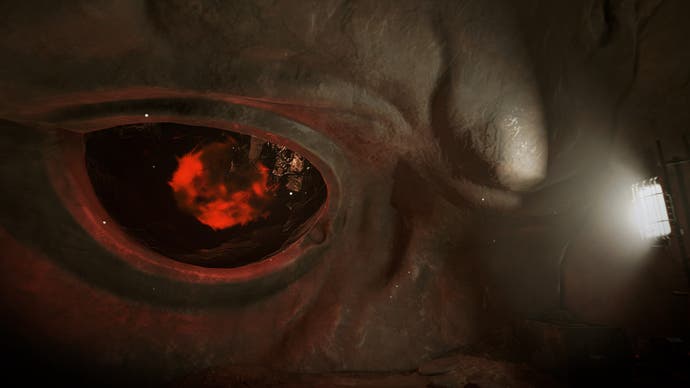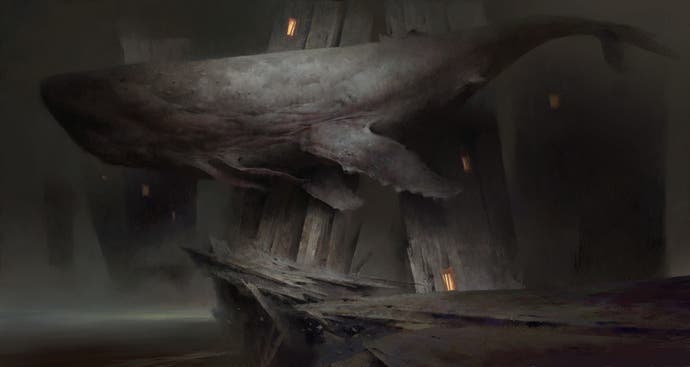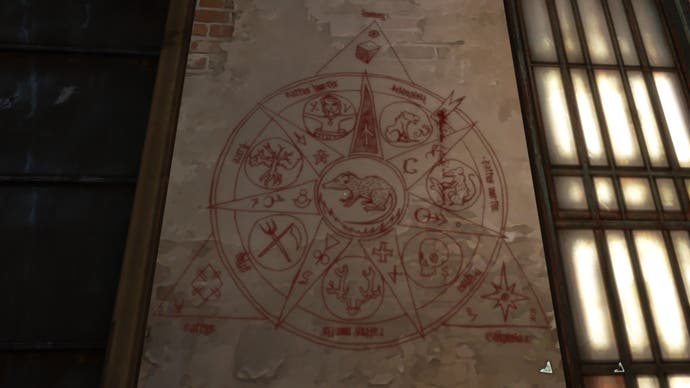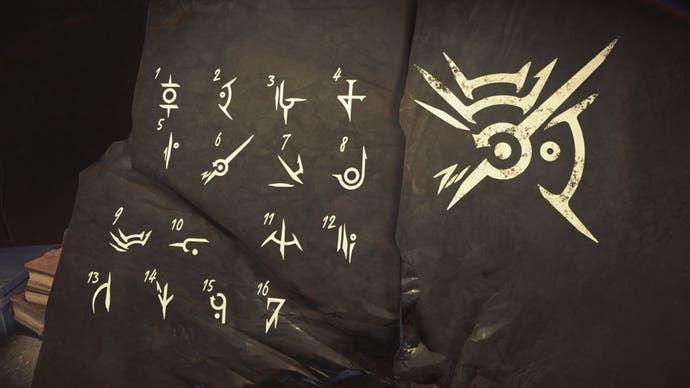The metaphysics of Dishonored
The Outsider walks among us.
There may be spoilers for the Dishonored series of games ahead.
"The Void is unspeakable. It is infinite and it is nowhere, ever-changing and perpetual. There are more things in the endless black Void, Kirin Jindosh, than are dreamt of in your natural philosophy" (Letter from Delilah). Despite the best efforts of natural philosophers, the world of Dishonored is defined by occult, unknown influences. Here, we performed dark magicks, battled witches, conversed with spirits, and even traversed the distance in-between worlds during our vendetta-fueled travels through Dunwall and Karnaca.
Any inquiry into the metaphysics of Dishonored stands and falls by the Void, that shadowy realm that is the source of all magic, witchcraft and arcane knowledge. Even the Outsider, who appears as an ancient god that grants his arcane mark to the player, ultimately derives his powers from the Void, not the other way around. But the Void is an elusive place that doesn't give up its secrets readily, and we as players don't understand it any better than the seekers of Gristol or Serkonos who struggle to catch so much as a glimpse of it. So, what exactly is the Void, or rather, how should we think about it to make sense of it?

Even tentatively trying to figure out how the Void is positioned relative to the natural world, that is, how it fits into a coherent cosmology, is a tricky task. Sometimes, the shifting Void seems to be a place entirely its own, existing largely independently of that other world. Sometimes, it appears as a reconfiguration or twisted mirror image of fragmented and distorted places existing in reality, or even as a parallel dimension existing alongside the natural world while sometimes overlapping or intruding into it. You could even make the case that it exists "below", beneath the surface of the material plane, as the whales floating (swimming?) through the Void almost seem to suggest.


Perhaps there are analogues in the history of mythology or philosophy? Hell might seem like the most obvious contender at first, but the comparison falls apart quickly. It may be a sinister place and there is some evidence that it serves as some sort of afterlife. But while the spirits of Daud and others you encounter in the end of Death of the Outsider don't seem too happy there, they're not exactly being tortured by anything besides their own regrets. (And if you're interested in an argument against an interpretation of the Outsider as the devil, read Hazel Monforton's excellent PC Gamer piece on the matter.)

A better choice might be the primordial chaos of various creation myths (such as the Greeks'), which is seen as the unformed state of the cosmos before it was given shape through an act of creation or separation that brings order to the chaos. Given the Void's frequent association with the ocean, the description of the unformed cosmos in Genesis is especially tantalising: "And the earth was without form, and void; and darkness was upon the face of the deep. And the Spirit of God moved upon the face of the waters" (King James translation). Of course, the Void differs from the primordial chaos insofar as it exists alongside the fully formed world. But then again, we know that time works very differently in the Void, so it might be possible to view it as a sort of remnant or glimpse of that original chaos.

Speaking of forms: it may also be useful to think about the Void in terms of Platonic idealism. To grossly oversimplify, Plato's theory of form and the schools of thought it would later influence posited that we live in an imperfect world and that the things we perceive are like distorted shadows thrown by ideal, unseen forms. In other words, there exists, depending on interpretation, either a metaphorical or very real realm of ideals whose emanations constitute the world as we see it. Given how the forms of the natural world often appear in the Void as fragmented, twisted shadow images, it could be said that the Void is to the world of Gristol and Serkonos as the imperfect world of Platonic thought is to the realm of the ideal. And yet, it's more complicated than that. After all, the Void is more ancient than the world of humans, and heretics all over the Empire believe that the Void holds deeper truths than the natural world. And the powers that are bestowed upon them by the Void seem to confirm this belief.
The Void manifests itself in the natural world in different ways. As mentioned above, there seems to be a sympathetic affinity between the Void and the ocean. As a result, the creatures that live in the deep waters have special connections to the Void. The whales of Dishonored are mysterious creatures whose song seems to have a special effect on the people of Dunwall and whose bones are carved into whispering scrimshaw that channel the powers of the Void. Dishonored's whales are a clear echo of Hermann Melville's Moby-Dick (1851), where whales appear as elusive, ancient gods of the deep. Little was known about whales even at the height of the whaling industry in the 19th century, and Moby-Dick as well as Dishonored capture the aura of mystery they still exuded at that time. Like the hieroglyphs left behind by ancient civilisations, Melville wrote, "the mystic-marked whale remains undecipherable."

Delirium is another way to connect with the ocean-like Void. Disease-carrying creatures like rats and bloodflies have hidden potentials: "I convinced our little group that less gentle methods were needed if our desire to meet the Outsider was sincere. Bloodfly fever, voluntarily induced. That will be our way to the Void. [...] The fever was quick to set in. As I faded in and out of consciousness, ocean waves pounded above me. There were silhouettes in the distance, and shimmering black rocks" (Séance Notes). Plague rats are often depicted in many occult diagrams found in Dunwall and Karnaca. Their bodies dominate the centre, connecting the spikes of compass-like diagrams or the branches and roots of trees adorned with alchemical or astrological glyphs.



These and similar diagrams and symbols lead us directly into the complex tangle of ritual magic, witchcraft, alchemy and mysticism. The topic is too convoluted to go into any detail here, so suffice it to say that in the world of Dishonored, many individuals and groups, from exiled nobility and occult philosophers to covens of witches and the cult of the Eyeless, try to use the Void for their benefit. Their motives are diverse: they seek revenge, power, aesthetic inspiration, wealth or immortality. And some, especially at the margins of society, use its power to defy the agents of a repressive society, the Abbey of the Everyman.


The Abbey is clearly modelled after the Inquisition, both in their aim of combating heresy (which has here been completely conflated with witchcraft) as well as their often brutal methods. From their point of view, the Outsider is almost indistinguishable from the devil as seen during the great European witch hunts of the 16th and 17th centuries. In Death of the Outsider's Conservatory mission, we stumble upon (potentially unreliable) confessions extracted by torture. One of them tells of a witch who consorted with a familiar spirit called Sugarboy and supposedly used the stolen blood and seed of a former lover to make him sick and impotent. These confessions tick all the boxes of accusations made against historical women condemned of witchcraft.
And yet it would be misleading to view the Abbey exclusively as an analogue for the Inquisition or the Catholic Church (not least because the Inquisition wasn't as involved in the war against magic as you might think). The Strictures might be an obvious allusion to the Scriptures, but they only proscribe, never promise. What does the Abbey believe in? Their texts never mention a god or a benevolent counterpart to either the Outsider or the Void. The closest tie to the spiritual that they have is the Ancient Music, a kind of counter-song against the arcane song of the whales: "Throughout the natural world there are ripples that we can barely perceive with our senses, an Ancient Music permeating everything as fundamental structural rule. Through it, you can work wonders without violating the natural world or begging favours from unfriendly spirits" (The Ancient Music). This Ancient Music is very similar to an ancient religious and philosophical concept called the Music of the Spheres, or the Musica Universalis, the idea that the movement of the planets, perfectly ordered by a Creator, emits harmonious sounds. Yet the Abbey is curiously uninterested in the theological or spiritual implications of their discovery, using it simply as a tool to torture witches and counteract the Void's magic.

The Abbey is a less religious institution, more precursor to a fascist police state. And through their single-minded obsession with eradicating everything touched by the Outsider's hand, they reveal deeper truths about the Void despite their distorted perspective. To them, the Void isn't simply a source of evil, but a force that destabilises their authority by offering an abundance of alternatives. In the Selected Sayings of the Overseer, we read: "Know this: There is only one path. It is the job of the Outsider to convince you there are many" or "One heretical thought leads inevitably to more, as a single errant weed soon overtakes the field of wheat." There's an escalating plurality, a dark fertility to the Void that terrifies the Abbey: One paths becomes many. A single thought multiplies. The Void stands for multiplicity and countless possibilities. For every door the Abbey locks, it opens three more.
And this is precisely why it is so hard to define what the Void is. Despite Dishonored's historical setting and influences from mythology, therefore, the Void is a quintessentially postmodern place. Ambiguity, fluidity and a plurality of meaning is its only constant nature. And this is also why the Void finds its reflection in the ocean, delirium and diseases. Like the Void, they exist at the very edge of human understanding (at least in the 19th century world of Dishonored).
The genius of the Dishonored series is that by the very act of playing the game, you align yourself with the Outsider and the Void whether you want to or not. Its openness, flexibility and emergent design mean that you cannot help but act like the Outsider who sees many paths where others see just one. Experimenting with your arsenal of tools and powers to find ever new surprising synergies and possibilities mirrors that fertility of the Void that allows one thought to become a myriad. This way, the Dishonored series' metaphysics manifest themselves in the moment to moment actions of the games. You cannot embrace Dishonored without also allowing the Void to embrace you.









